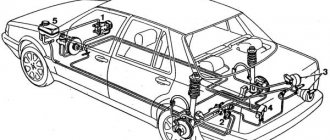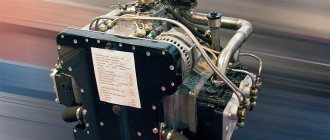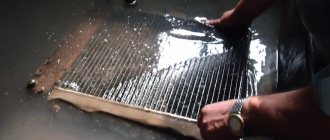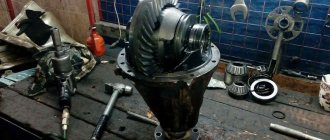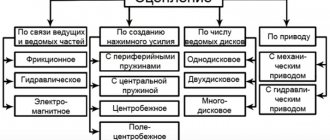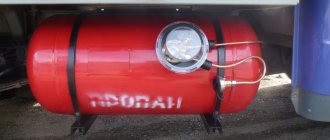Due to rising gasoline prices, many car owners began to equip their “iron horses” with gas equipment (LPG) in order to somehow save their finances. However, along with the new equipment, new troubles also appeared - its maintenance and configuration. Therefore, today we decided to address the problem of adjusting the gas reducer. After all, this must be done not only immediately after installing the LPG on the car, but also during the operation of this system.
- 1. Gearbox adjustment: what is needed for adjustment?
- 2. Gearbox adjustment methods
The longer the mileage of the LPG and the period of its operation, the more necessary this adjustment becomes. The fact is that over time, the rubber elements of gas equipment - valves and membranes - can change their properties, which, in turn, leads to excessive gas consumption. Of course, such consequences can occur only after 3-4 years of operation (this is approximately 100,000 km), but you should prepare for this in advance.
Gearbox adjustment: what is needed for adjustment?
Before you begin to get acquainted with the basic methods by which the gearbox is configured, you need to become more familiar with this device and its main characteristics. After all, it is the gas reducer that plays the most important role in the normal functioning of gas equipment. What is its main task? It is thanks to this unit that the driver of a car with gas equipment can reduce the gas pressure that comes from the cylinder. At its core, this is a rather primitive pressure regulator, which allows you to autonomously maintain the same pressure indicator.
But, since nothing in this world is perfect, the pressure may still fluctuate slightly during operation of the gas reducer. In practice, it looks like this: when gas consumption is stable, the pressure also remains at a given level, and when it begins to be consumed more intensively, the pressure may drop slightly.
Although in general this process does not pose any danger, it is still necessary to be aware of it.
As we already noted in our introduction, gearbox adjustment is necessary during the installation of a new gas equipment on a car, as well as after its long-term operation. But in addition to these factors, the need for the frequency of adjustment and the specifics of performing this task is also associated with:
– generation of gas-cylinder equipment and, accordingly, the gas reducer itself;
– the number of regulators that are on the gas reducer;
– the fuel system on which the car engine runs – gasoline or diesel.
The gas reducer contains membranes that can freeze at low temperatures. For this reason, the gearbox must be connected to the automotive cooling system. If we talk about the operation of this gas equipment element in general, it is important to note the following point: it is impossible to start the gearbox simultaneously with the engine. First you need to wait until the engine temperature rises to 30-50°C, and after that you can put the gas reducer into operation.
The design of a conventional gas reducer is also simple. In particular, this device consists of the following parts:
– separate chambers, the number of which may vary depending on the type of gearbox (from 1 to 3);
– idle channel;
– evaporator;
– a regulatory system that controls the supply of gas from cylinders to the combustion chamber of the engine.
But on modern gas equipment you can find two types of gearboxes. They have a number of very important differences between themselves, which, in particular, has a significant impact on the process of setting them up. Let's look at the features of each of them:
1. Vacuum reducer. To put such a gearbox into operation, you must perform a number of mandatory actions:
– put the switch in the “Gas-Petrol” position;
– turn the key in the ignition;
– warm up the engine.
When the first two instructions are followed, the required amount of gas is pumped into the intake manifold, which will then allow you to start the engine without any problems and hit the road. The same is ensured by the operation of the starter.
2. Electronic device of the gas reducer. It turns on only when the switch is in the “Gas” position. Similar to the vacuum reducer, we turn on the ignition and give the starter the opportunity to work a little until the required amount of gas collects in the intake manifold and the device itself warms up to the desired temperature.
To properly configure the gas reducer, you need to understand absolutely everything about its settings. Thus, a large number of propane-type reducers are characterized by two regulators, although there are a small number of models with one. But methane analogues, on the contrary, almost always have only one regulator. It is the correct setting of the gas reducer regulator that is the main problem for car owners.
We recommend: Types of diesel engine power systems
Why are two regulators installed on gearboxes? The first of these is the idle air control. In the process of setting up the device, we will need to screw it all the way. But the bottom one is the sensitivity regulator . It is he who presses the gearbox membrane. Having become familiar with this device in more detail, you can proceed directly to the setup procedure.
And to the question of what is needed to set up a gas reducer, the answer will be very simple - you need patience and strict adherence to the instructions below. You should also remember that you will have to work with gas equipment, so all your manipulations must be extremely careful. If you do not feel sufficiently confident in your own abilities, it is best to seek help from a specialized car service.
Gearbox adjustment methods
As we have already noted, there are electronic gas reducers and vacuum ones. Setting up each of them has its own characteristics and differences, for which reason we will consider methods for adjusting each of them separately.
Electronic gas reducer - which setting method to choose?
On this type of device, two types of settings must be used:
1. Adjusting sensitivity, or adjusting pressure in the second stage.
2. Adjustment according to the amount of gas that moves through the idle channel.
But before you begin both, you need to take a few more mandatory steps. First of all, we start the car engine on gasoline so that it can first warm up to operating temperature. In this case, the idle speed is set between 950 and 1000 rpm.
When the engine temperature reaches the required level, turn off the gasoline supply and allow it to burn out the remainder.
After this, we prepare the car for direct adjustment of the gas reducer:
– turn the power register to maximum (if a two-chamber dispenser is installed, then open the first chamber completely, and the second to minimum);
– turn the idle screw completely, then turn it back exactly 5 turns;
– set the sensitivity regulator to the middle position.
Well, first of all, let's start adjusting the idle speed. To do this, we start the car, but on gas. Use the choke and bring the engine to 1700-2000 rpm. Next, you need to simultaneously perform two actions at once: remove the choke a little at a time and rotate the idle speed control until you can find the position in which the largest number of starter revolutions occurs. At the end of this procedure, the choke must be completely removed, and the car must begin to idle stably.
Having set the maximum number of starter revolutions using the idle speed regulator, gradually tighten the sensitivity regulator of the gas reducer. If during this procedure the number of revolutions begins to change, again try to bring them to the maximum using the idle speed control. If you can’t do anything with this regulator, try tightening the sensitivity screw two turns and repeat the whole procedure again from the very beginning.
The goal you need to achieve is the maximum number of starter revolutions at idle (approximately 1100-1200 rpm) , with the sensitivity regulator screwed almost all the way. But driving at such speeds is not recommended, since their value should be below the nominal norm. Therefore, we again tighten the idle speed control until the speed drops to 950-1100 rpm.
Now let's move on to setting the sensitivity of our gas reducer. We also slowly turn off the sensitivity control and monitor how our actions affect the starter speed, which it performs at idle. When we felt that the number of revolutions began to change, we twist the regulator back a little - about ¾-5/4 turns. Do not forget to also check the engine operation by sharply pressing the gas pedal. If you did everything well, he will respond immediately and without jerking.
When adjusting the gearbox, it is very important not to forget to adjust the power register. To do this, it is necessary to bring the starter of the working engine to 3-3.5 thousand revolutions per minute, while simultaneously tightening the power register regulator. This must be done until the starter speed begins to decrease. To make sure you achieve what you want, try moving the gas metering screw from place to place and unscrewing it about ½-3/4 turn from the found position.
We recommend: How to start a car in winter? 7 ways to cold start
But don’t worry about the fact that there are dispensers that consist of two sections. In this case, all the above steps must be applied only to the first camera, and the second one must be adjusted to only 25-30% of the first.
Some gas reducers also have the ability to adjust the pressure in the 1st stage.
To make the adjustment, you need to completely turn off the engine, shut off the line through which the gas flows, and connect a pressure gauge to the cavity of the first stage (it is advisable to use a pressure gauge with a scale of 1.5 kgf/cm2, and it is connected through a control hole, which is turned off using a regulator). After this, we open the gas line again, start the engine idling and bring the pressure of the first stage to 0.38-0.42 kgf/cm2.
Ideally, after adjusting the power register, you need to once again adjust the idle speed and sensitivity of the gas reducer. Only after this can you proceed to the final setup stage, which consists of several steps:
1. We press the gas pedal very sharply.
2. We turn the sensitivity control 0.25 turns until the intensity of the revolutions begins to decrease very much.
3. We turn the regulator back 0.5 turns and let the engine run a little, carefully monitoring the stability of this process.
What do you need to know about setting up a vacuum gas reducer?
Setting up vacuum type gas reducers can also be done in two ways:
1. The sensitivity and idle speed of the gas reducer can be adjusted separately.
2. The sensitivity and idle speed of the gas reducer can be adjusted simultaneously.
As for the first setting method, it is no different from the process of adjusting the electronic gas reducer, which we have already described above. For this reason, we will look at how to combine these processes.
First of all, we tackle the idle speed. To do this, we start the car, but immediately on gas, not gasoline. Again, using a choke, we level the engine speed to 1700-2000 per minute. We slowly remove the choke and, using the idle speed regulator, achieve the maximum value for the number of starter revolutions (at the end the choke must be completely removed). Using the regulator, we achieve the speed intensity within the range of 1000-1100 rpm and at the end we set the norm - 950-1100 rpm, by tightening the regulator a little more.
Setting the vacuum gear power register is almost the same as setting it on an electronic prototype. In particular, you need to do the following:
– start the engine at idle speed;
– set the intensity to 3000-3500 rpm;
– turn the regulator until the speed starts to drop;
– we try to adjust the register regulator, trying all the values;
– unscrew the register regulator by 0.5-0.75 turns, and also slightly adjust the idle speed.
Subscribe to our feeds on social networks such as Facebook, Vkontakte, Instagram, Pinterest, Yandex Zen, Twitter and Telegram: all the most interesting automotive events collected in one place.
What is a gas reducer?
The principle of operation of the gas reducer in household gas cylinders, in the main gas pipeline network, where pressure adjustment is required, in the gas equipment of cars, is similar. This device is designed to reduce the pressure of gas fuel and maintain this pressure at an optimal level.
If the device does not cope with its functions, the safety and performance of the gas system will be at risk.
Read more: Car blind spots in the mirrors
In all cases, the task is the same: to ensure that the gas pressure is always at a given operating level.
To understand the principle of operation, the device can be divided into series-connected zones separated by valves. The most important of them, the unloading one, additionally performs the function of an injection dispenser. The device contains an evaporator, as well as an idle channel.
On a note! In innovative gas equipment kits of the 5th and 6th generations, installation of a gearbox is not required: gas injection occurs in a liquid state.
Gearbox BRC AT90E
1 — idle screw. 2 — sensitivity screw. 3 - plug (do not twist). 4 - screw for draining condensate.
© January 23, 2008. Author: Yumbre.
Based on forum materials. You can discuss the article in a special topic on the forum.
I understand that the topic has been discussed by everyone for a long time, there is a lot of controversy about this, but still... And so, we have LPG (usually called the second generation), I will not describe the entire system, I will only touch on the evaporator reducer and dispenser. So. Italian electronic gearbox evaporator Lovato and its exact copy of the Turkish Atiker with two adjustment screws. The first screw is brass, very often it is called the idle screw, but... translating the instructions for the Lovat gearbox, it was written there that this is an ADDITIONAL SCREW XX. The second screw is plastic, very often it is called the sensitivity screw, although in the instructions it is designated as an idle screw. Now attention! This is the instruction manual for the Lovato gearbox in Russian. You can find it on the Internet in doc format.
On what principle does the device work?
The temperature of the antifreeze should rise to 40. The operation of the gas reducer is possible only after the car has warmed up well. How does a gas reducer work on a car?
- Liquid gas from the reservoir enters the filter and is purified. There it remains while the solenoid valve is closed.
- The fuel then passes through the 1st stage valve seat and turns into steam. The membrane, under its pressure, pulls back the valve rocker arm, it lowers onto the seat and the gas flow stops. This gives a working pressure of 0.4 atm. It is adjusted by a spring mechanism.
- Automotive gas fuel moves further to the 2nd stage valve seat. The fuel then goes through the outlet fitting to the engine.
Idling
Operating principles of gearboxes in various generations of gas equipment
Despite the fact that the principle of operation of the GBO gearbox of generations 1, 2, 3 and 4 is subordinated to a single task, the equipment of the device varies depending on the generation. The unloading compartment locking methods and settings are also different.
1st generation gearbox
In the 1st generation there was a vacuum device of a mechanical type. The membrane plate responded to the vacuum in the intake manifold, to which an additional line was extended. When the engine started, the carburetor began to draw in fuel, the pressure dropped, and the vacuum valve opened the way for fuel. The engine was turned off, the pressure returned to normal and the fuel inlet was blocked. The device was adjusted simply: by mechanical rotation of the greed screw. These are the main differences in the operating principles of the gas reducer of the 1st and 2nd generations.
2nd generation gearbox
The operating principle of the 2nd generation gas reducer has evolved. Now this is not a vacuum, electronic device. An important addition: it is equipped with a solenoid intake valve controlled by the power unit. This ensured an automatic response of the device to starting the car engine. The solenoid valve supplies gas based on impulses from the oxygen sensor. This is the main advantage of an electronic type device, since older carburetor engines do not always have enough vacuum for the membrane to work.
Gearbox 3rd and 4th generations
In the 3rd and 4th generations of HBO, this device is simplified in design. Some options have been transferred to the collector. There is no need for a large number of membrane partitions. For a split injection system, 2 stages and one solenoid valve are enough.
The number of sensors has become larger in number. A complex design filter device was added to ensure gas purification.
The mechanism has become more convenient to configure. The electronic control unit is connected to the laptop. A special program is launched that performs configuration and diagnostics. Devices from the brands Tomasetto and Lovato are easy to adjust.
The operating principle of the gas pressure reducer must be taken into account when choosing this device. Pay attention to what generation it belongs to, whether it has dust and moisture protection. Power characteristics should be with reserve. But the dimensions must correspond to the area that can be allocated to the device in the engine compartment.
One of the main components of the gas cylinder system on a car is the LPG reducer. The correct and stable operation of the car engine, with the lowest gas consumption, depends on its choice, as well as further operation.
Pros and cons of HBO Lovato
Since the company’s equipment belongs to the 4th generation, the transition to this system has a number of advantages. Firstly, the reduction in engine power is only 2%, which is quite insignificant. Also, the cost of gas is much lower than fuel produced from petroleum products.
Due to its chemical composition, gas does not contain harmful impurities, which has a beneficial effect on the environment. This also helps protect car parts from metal corrosion. Consequently, the car owner will have to change spare parts less frequently, and this will save a lot of money.
Also, an undeniable advantage of installing Lovato LPG is the low cost of installation. On average, the owner will have to pay from 19 to 47 thousand rubles, depending on the vehicle.
It is worth noting that the Lovato company uses the Lean Production system in its production, which completely eliminates the risk of defects. In addition, the company has many certificates that confirm that all products meet quality standards.
In gas-cylinder equipment, the gearbox is given the greatest importance among all components. Its task: to provide the driver with the opportunity to reduce the pressure coming from the cylinder. Repair, namely adjustment, on a car gearbox involves working with one or two regulators: this is the main difference.
In principle, a gas reducer is a primitive pressure regulator designed to independently maintain a standard pressure value based on fuel consumption. As practice shows, the device supports it with minor fluctuations. The pressure decreases slightly with increasing gas flow. This is not a very significant point, but requires attention.
GBO reducer device
Equipment is divided into the following types:
- Vacuum - compatible with carburetor engines, suitable for 1st-2nd generation gas equipment systems.
- Electronic models are used for the second, third, and fourth generations of gas equipment, in cars with a carburetor and injector.
The metal body of the mechanism consists of several stages (chambers) with channels, their number depends on the manufacturer, as well as equipment modifications. Most often, these devices are made in a two-stage or single-stage version, and come with three stages. They work with a propane-butane mixture or methane.
Thus, the vacuum two-chamber gas pressure reducer of the 2nd generation (aka 1st generation) contains:
- Hole for inlet line and gas supply fitting;
- Adapters for inlet/outlet of heating fluid into an isolated cavity;
- Diaphragm with spring;
- Reducing (evaporation) stage valve;
- Sensitivity diaphragm, second chamber valve;
- Adjustment screws;
- Electrovalve for forced gas supply;
- Drainage hole for draining condensate;
- Vacuum fitting (unloader).
The electronic gearbox of the 4th generation HBO (both the 2nd and 3rd) consists of:
Read more: How to bleed brakes on Izh 2126
- Fuel inlet/supply;
- Angles for supply/discharge of heating fluid;
- Electromagnetic gas valve (on some models it is installed remotely);
- Built-in coarse fuel filter (not available in all devices);
- Diaphragm with spring and evaporation stage valve;
- Sensitivity diaphragm, valve of the second chamber (two-stage version);
- Adjustment screws (applicable to 2nd generation);
- Emergency gas release valve;
- Gearbox temperature sensor (thermistor).
Gas equipment Lovato
Most domestic motorists choose Lovato brand LPG, as it belongs to the fourth generation. Also, this equipment is recommended to be installed by car service technicians, since installation does not require special knowledge, because the Lovato LPG setup is carried out using a simplified system.
It is important that the manufacturer provides a warranty on its components for a period of 3 years. This time is quite enough for a mileage of up to 300 thousand kilometers. This figure is one of the highest among 4th generation HBO. According to average data, this is enough for 5 years. When compared with similar companies in this field, their figure is much lower.
However, despite the high results, the driver should remember that it is necessary to promptly diagnose the 4th generation Lovato HBO. Because this will help not only to identify malfunctions, but to a greater extent the safety of operating the vehicle depends on it. Many masters claim that it is periodically necessary to adjust the control unit on the Lovato HBO.
Important! The Lovato company is a monobrand, since it produces all its equipment independently. When purchasing gas equipment from this company, consumers can be sure that all the parts included in the kit are made in Italy.
Lovato HBO must be installed only in specialized car repair shops, since poor installation can lead to malfunction and the system will not be able to function normally. If the installation is completed correctly, the system notifies you with a “Chicken Engin” signal.
Many drivers note that after switching to gas, engine power is greatly reduced. However, this problem is obvious, because during combustion gas has a temperature higher than liquid fuel. But this problem was solved with 4th generation equipment - at the moment, gas enters the engine system in the same way as gasoline. Therefore, the power reduction is only about 2%. Thus, the power of a vehicle is influenced by the quality of the fuel it fills.
Principle of operation
The main function of the reducer-evaporator (option with propane fuel) is to reduce the pressure of the gas mixture coming from the cylinder in the liquefied phase at a pressure of 16 atm., to the working pressure (1-2 atm.). Its transformation into a gaseous state by heating it from the engine coolant and supplying/dosing it to the combustion chambers of the engine.
The key reason why a device fails is membrane wear. Therefore, before switching the engine to gas, it is first warmed up on gasoline.
Operation of the vacuum reducer-evaporator
Liquefied gas, flowing from the cylinder through the multivalve to the reducer, overcomes the force of the valve, which is pressed by the spring of the first stage membrane. Next, the gas mixture expands, heating up from the circulation of antifreeze/antifreeze in the heat exchange cavity, which affects the membrane, which moves the rocker arm, pressing the rubber valve to the seat, cutting off the fuel supply.
The gas then flows in vapor form into the second chamber, opening the valve, from where it flows to the engine. This cycle is carried out with the engine running, due to the vacuum in the line supplying the carburetor, by the method of gas ejection (suction). If the internal combustion engine stops operating, by analogy with the first stage, the gas mixture, filling the space, puts pressure on the diaphragm, closing the valve, stopping the flow of fuel.
Forced gas supply occurs to enrich the fuel mixture when starting the engine, from inside the car, by pressing the gas equipment control button.
To ensure fire safety when the internal combustion engine is switched off, an unloading device is activated, which consists of a spring with a pusher that supports the rocker arm of the second stage valve, cutting off the gas supply. When starting the engine, the diaphragm of the device, under the influence of vacuum from the intake manifold through the tube and fitting on the gearbox, overpowers the elasticity of the spring, thereby stopping preventing the movement of the valve rocker arm.
Operation of the electronic mechanism
Such devices are the most efficient and economical. There are no fundamental differences in the principle of operation of the 2nd generation gas evaporator with electrical control and the 1st generation vacuum gas evaporator. Except that in the first embodiment, gas is supplied with the participation of an electromagnetic valve.
But the operating principle of the 4th generation LPG gearbox, as well as its control, differ in many respects due to the lack of a second chamber. In cars with such equipment, gas fuel is supplied by distributed injection to each cylinder. This approach requires maintaining stable pressure in the 4th generation LPG reducer (1-1.4 atmospheres depending on the internal combustion engine of the car). The mechanism is controlled by a gas system controller, which receives signals from a number of sensors.
When the operating temperature of the LPG reducer reaches 40-60°C (adjustable using software), a signal from the device’s temperature sensor is sent to the equipment’s ECU. Based on this, the control unit automatically switches the fuel system from gasoline to a gas mixture by applying an impulse to the solenoid valve coil, which doses the liquid phase of the gas into the cavity, where, when heated, it turns into vapor form, then flowing to the injectors.
To adjust the equipment at idle and emergency fuel discharge into the suction manifold, a vacuum tube from the engine intake tract is connected to the fitting of the mechanism.
Which equipment is better and what to choose?
Equipment for carburetor cars was developed back in the 30s of the last century. Of course, during this time many modifications and improvements have been made, but the principle of operation remains the same. These installations are considered the first generation. All subsequent ones have a more complex design with electronic control units.
1st generation LPG on a carburetor is the most optimal solution for those who independently service and tune their car (generations starting from the 2nd generation are installed on the injector). When buying equipment, you should carefully consider the choice. Manufacturers from Italy, represented by such brands as Bigas, LOVATO, OMVL, etc., have earned a good reputation among motorists.
Particular attention should be paid to LOVATO products; this company has been developing and manufacturing gas equipment for various applications for more than 50 years. Certified in more than 50 countries around the world. The price for such equipment starts from 8,500 rubles. The cost depends on the configuration.
How to choose the right gas pressure reducer
The automotive market offers gas equipment from various manufacturers. When choosing a suitable gearbox model, you need to pay attention not only to the price and appearance of the product. The technical and operational characteristics of products are of great importance.
Only an experienced installer can advise which device is best for a specific car, but he will not always give the right recommendation in the pursuit of profit.
You just have to remember that the main criteria for deciding which 4th or 2nd generation LPG gearbox is best installed for operation on methane or propane-butane are:
- The power of the device is selected with a margin of 10-20% to the power of the car engine;
- Maintainability of the mechanism;
- Availability of original repair kits for replacement, spare parts for maintenance and repair;
- Small dimensions for convenient placement in the engine compartment;
- Optimal cost for quick payback;
- Ensuring gas supply over a wide temperature range;
- Possibility of draining condensate on the 2nd generation of gas equipment;
- The presence of built-in fuel filtration to the gearbox;
- It is desirable that the design of the antifreeze “jacket” eliminates the risk of gas getting into the coolant;
- Availability of a complete set of the unit.
In addition, there are models whose design includes rod valves, their advantage is reliability and durability compared to rocker valves. But they have one big disadvantage: when operated on low-quality gas, when they become dirty, pressure surges in the fuel system appear.
It is important to know that the service life of the LPG gearbox largely depends on the car owner’s compliance with operating rules. Also, it is best to select equipment from official representatives of manufacturing plants. Limiting yourself from numerous fakes!
List of popular gearboxes for gas equipment of 1,2,3,4 generations with the main characteristics:
Varieties
Reducers are equipped with cylinders for storing various gases - acetylene, hydrogen, argon, oxygen, propane-butane, etc. For convenience, they are painted in different colors. Reducing devices are conventionally divided into models for flammable and non-flammable mixtures. Cylinders for flammable gases are equipped with a left-hand thread. On containers of the second type, right-hand threads are used. This prevents erroneous switching of the reducer for a different type of gas.
Reducing devices used to equip containers with liquefied hydrocarbons are supplemented with developed fins. This prevents freezing of the gas mixture inside the supply pipe. Gearboxes intended for use in industrial environments are usually equipped with 1-2 pressure gauges.
Similar articles
- How do gas fire extinguishing systems work?
- Re-certification of gas cylinders
- New gas cylinder or certified?
